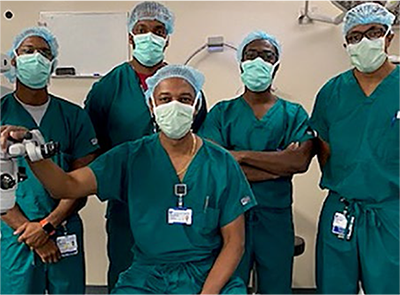Download PDF
The Power of Representation in Ophthalmology
A recent photo has been making the rounds on social media, showing Leon W. Herndon, MD, and his trainees after a case. I was struck by the beauty and power of the image and decided to contact Dr. Herndon to ask him how this photo originated.
He replied, “I have never had an all-Black team in my 25 years at Duke. In the history of the program, there had only been three Black residents until last year when we had a Black resident in every class (class size six). I realized that my entire team was comprised of brothers! So after my first case, I asked the circulating nurse to take a picture of this historic moment. I told the young guys that since I was old, I would sit, and they would have to gather around me.”
 |
At a time when the Association of University Professors of Ophthalmology (AUPO) is dedicating a large portion of its upcoming 2021 meeting to the issue of diversity and inclusion in ophthalmology residency training programs, this image strikes an important chord. Keith D. Carter, MD, FACS, spoke at the Women in Ophthalmology luncheon at the 2020 AUPO annual meeting about efforts made to increase diversity within our field—and how, despite these efforts, underrepresented minorities remain, well, underrepresented in our field.
The Academy is doing its part, too, supporting the work of its own Committee for Resident Education by creating a resource page for diversity and inclusion (aao.org/diversity-and-inclusion-education). This page includes articles on health care disparities in ophthalmology and the effects of race on eye disease outcomes as well as a list of books to consider for departmental reading and discussion with suggested questions to spark conversations.
We need positive images like this that show us all examples of Black physicians, much like the “I am a surgeon” social media campaign that highlighted women surgeons. We must all be a part of the solution and help mentor and promote underrepresented minorities in our training programs and practices for the betterment of our profession and our society.
Laura K. Green, MD
Krieger Eye Institute, Sinai Hospital of Baltimore
Chair, Academy Committee for Resident Education
President, AUPO Program Directors Council
___________________________
Editors’ note: A collaboration between the Academy and AUPO, the Minority Ophthalmology Mentoring program aims to increase diversity in ophthalmology. Learn more at aao.org/minority-mentoring.
Support Vision Foundations
Today, hundreds of organizations work to fight vision loss around the world. Thanks, in part, to their efforts, the global prevalence of moderate to severe visual impairment decreased from 3% to 1.9% from 1990 to 2010.1 However, access to vision care remains problematic, even in the United States. As a society, we rely on charitable organizations to address the visual needs of our most vulnerable.
When COVID-19 began to spread, the work of organizations that fight vision loss suffered. Many optical laboratories were deemed nonessential, and school vision programs were cancelled. Free or reduced-cost sight-saving procedures were postponed indefinitely. The effects went beyond delivery of care, devastating the very foundation of these organizations. Funding that had often been procured through community outreach and grants was redirected toward COVID relief.
Even so, these organizations remained true to their missions. For example, in northeast Ohio, Sight for All United, with which we are affiliated, was able to collaborate with national organizations like Essilor Vision Foundation and optical providers like Classic Optical Laboratories to distribute over 100,000 pieces of PPE, including goggles and face masks, to frontline workers and first responders.
Now hoping to return to a semblance of normality, charitable organizations are rethinking the way they operate. In an era of virtual education, school-based vision programs will be nearly impossible to implement. For programs focused on adults, those who are at highest risk for vision loss may now be less likely to seek vision services. Further, many providers are facing financial difficulties of their own and may be less capable of seeing those referred from charitable organizations.2
As ophthalmology practices transition back to normal patient care, providers must remain cognizant of the immense vision need that exists in their communities and the essential role that these charitable organizations play. As a community, we must continue to support these foundations and help those affected by vision loss.
Ankur Parikh, BS
Sergul Erzurum, MD
Northeast Ohio Medical University
Rootstown, Ohio
___________________________
1 Stevens GA et al. Ophthalmology. 2013;120(12):2377-2384.
2 Parke DW. JAMA Ophthalmol. 2020;138(6):599-600.